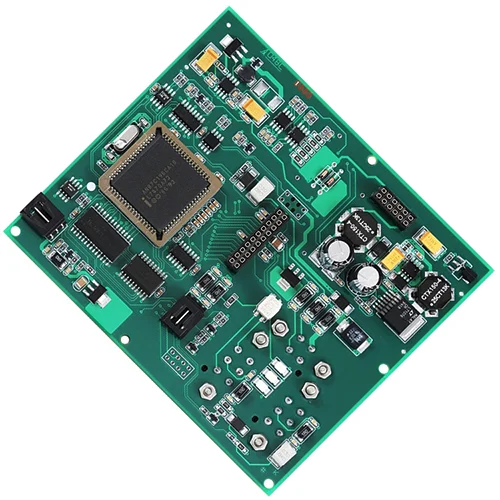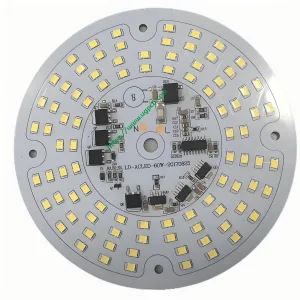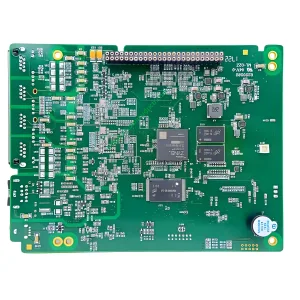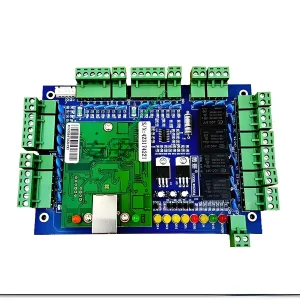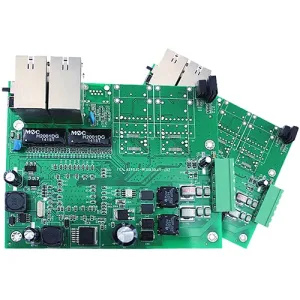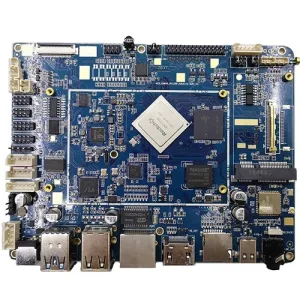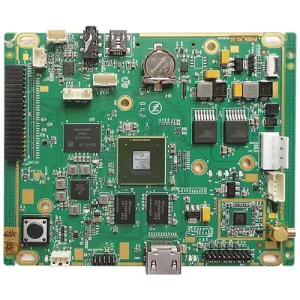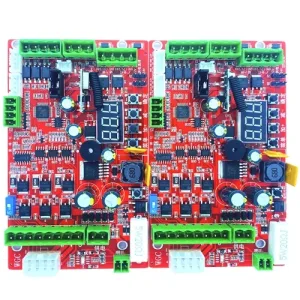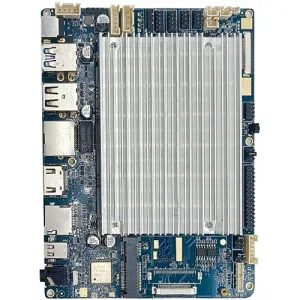Basic Overview
What is a Development Board?
The development board is a circuit board used for embedded system development, including a series of hardware components such as central processing unit, mémoire, input device, output device, data path/bus, and external resource interface.
Platforms in Embedded System Development
In the general embedded system development process, the hardware is generally divided into two platforms: the development platform (hôte) and the target platform (target), c'est, the development board. The development platform refers to using a computer to connect to the target platform through a transmission interface, such as a serial port (RS-232), USB, parallel port, or network (Ethernet).
Purposes and Types of Development Boards
Development boards are generally customized by embedded system developers according to development needs and can also be researched and designed by users themselves. They are used by beginners to understand and learn the hardware and software of the system. Some development boards also provide the basic integrated development environment, software source code, and hardware schematic diagram. Common types include 51, ARM, FPGA, and DSP development boards.
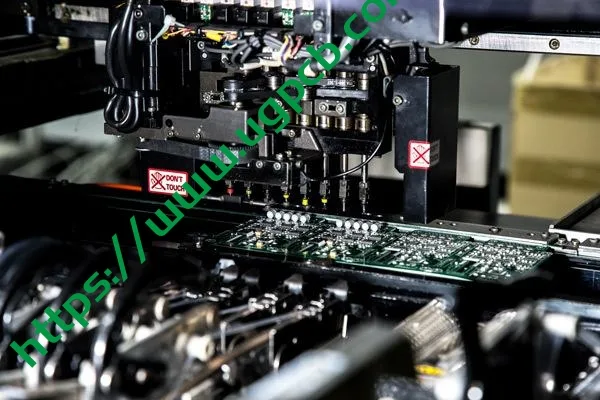
Assemblage SMT de la carte de développement de périphériques
Selection Requirements
For embedded system development, the first step is to select the type of CPU, FPGA, and DSP that meet the development needs. Alors, choose the range of development boards that support the selected chip. Preferences should be given to the ability and level of the development environment and technical support provided by the development board. Enfin, consider that the development board should integrate not only CPU, FPGA, DSP, etc., but also a relatively complete input and output interface, such as keyboard and LCD, program download interface, mémoire (BÉLIER), FlashROM, power supply module, etc.. Special pins, such as JTAG interface, USB, and serial ports, should be available for use by external debugging modules to facilitate debugging at the initial stage of development.
Development Migration
Initial System Development and Environment Setup
After selecting the hardware and specifications, the next step is to enter initial system development and establish an open environment. If the embedded operating system used in the project is purchased from other manufacturers, they mostly provide an integrated development environment (IDE) and an emulator to speed up the development process. Once the operating system provided by the system manufacturer is obtained and sufficient relevant information is confirmed, integration actions can be performed for the target platform.
Using Development Tools and Compiling
After selecting the operating system, the development tools used on the development platform are usually specified, such as compilers and linkers. The compilation parameters that need to be set during development will vary according to each environment. This part must compile an executable image file according to the hardware specifications and instructions, and then burn it to the target platform through the burning tool.
Development Board Classification
Single Chip Microcomputer
51 Series MCU
There are many types of 51 series single-chip microcomputers. 8031/8051/8751 are early products of Intel, while AT89C51 and AT89S52 of ATMEL are more practical. ATMEL’s 51 series also includes AT89C2051, AT89C1051, and other varieties. These chips are simplified versions formed after some functions are simplified on the basis of AT89C51. Currently available chips in the market include ATMEL’s 51 et 52 puces, HYUNDAI’s GMS97 series, WINBOND’s 78e52, 78e58, and 77e58.
PIC Series MCU
Overview of PIC Microcontrollers
All over the world, PIC microcontrollers can be widely used in various fields from computer peripherals, home appliance control, télécommunications, smart instruments, automotive electronics to financial electronics.
Classification of PIC Series
- Basic Series: Suitable for cost-sensitive household appliances (par ex., PIC16C5X).
- Intermediate Series: High-performance with features like internal A/D converter, E2PROM, comparator output, PWM output, I2C, and SPI interfaces (par ex., PIC12C6XX).
- Advanced Series: Rich I/O control functions, expandable with EPROM and RAM (par ex., PIC17CXX).
AVR Series MCU
Introduction to AVR Microcontrollers
AVR single-chip microcomputer is an enhanced RISC (Reduced Instruction Set CPU) with built-in Flash developed by ATMEL in 1997. It is a high-speed 8-bit single-chip microcomputer with reduced instruction set.
Applications of AVR Microcontrollers
AVR microcontrollers can be used in computer peripherals, industrial real-time control, instrumentation, équipement de communication, and household appliances.
ARM Development Board
Overview of ARM Development Board
The ARM development board is an embedded development version of the ARM core chip, including ARM7, ARM9, ARM11, Cortex-M, Cortex-A, and Cortex-R. Documentation is unified and facilitates development.
Manufacturers and Products
Chips from ATMEL, NXP, ST, and Freescale have launched chips based on ARM cores and corresponding development boards.
CPLD/FPGA
CPLD (Complex Programmable Logic Device)
CPLD is a large-scale, complex digital integrated circuit developed from PAL and GAL devices. Users can construct logic functions according to their needs.
Common CPLD Chips
- Altera EPM7128S (PLCC84)
- Lattice LC4128V (TQFP100)
- Xilinx XC95108 (PLCC84)
FPGA (Field-Programmable Gate Array)
FPGA is a semi-custom circuit based on programmable devices like PAL, GAL, and CPLD. It solves the shortcomings of custom circuits and limited gates in original programmable devices.
Common FPGA Varieties
- XC series of XILINX
- TPC series of TI company
- FIEX series of ALTERA company
DSP (Digital Signal Processor)
Overview of DSP
DSP is a microprocessor that processes a large amount of information with digital signals. It converts analog signals into digital signals, modifies, deletes, and strengthens them, then interprets them back into analog data or other formats.
Features of DSP
- Programmable
- Real-time running speed of tens of millions of complex instruction programs per second
Mainstream DSP Chips
- DE 2000 série, DE 5000 série, TI6000 series
- ADI DSP series of ADI Company
ARM
Overview of ARM
ARM (Advanced RISC Machines) is a class of high-performance, cheap, and low-power RISC processors designed by ARM, a well-known company in the microprocessor industry.
Applications of ARM
Applicable to embedded control, consumer/educational multimedia, DSP, and mobile applications.
Mainstream ARM Categories
- ARM7TDMI: Game Boy Advance, Nintendo DS, iPod
- ARM9TDMI: Armadillo, GP32, GP2X (first core), Tapwave Zodiac (Motorolai. MX1); GP2X (second core)
- ARM9E: Nintendo DS, Nokia N-Gage, Conexant 802.11 puces; ST Micro STR91xF
- ARM11: Nokia N93, Zune, Nokia N800, NOKIA E72
- Cortex: Texas Instruments OMAP3, Broadcom, Luminary Micro family of microcontrollers
MIPS
Overview of MIPS
MIPS (Microprocessor without interlocked piped stages) is a popular RISC processor worldwide. It uses software methods to avoid data-related problems in the pipeline.
History and Development of MIPS
Developed by Stanford University in the early 1980s, MIPS products are used in Sony, Nintendo game consoles, Cisco routers, and SGI supercomputers.
MIPS Processor Cores
- MIPS324Kc: High-performance, low-voltage 32-bit MIPS RISC core for System-On-a-Chip.
- MIPS64 5Kc: High-performance 64-bit processor core.
- MIPS32 4KcTM: Specifically designed for System-On-a-Chip using MIPS technology.
- MIPS 64 20Kc: Strong floating-point capability, suitable for graphics workstations.
- MIPS R12000: Applied in SGI’s server, with a main frequency of up to 400MHz.
Applications of MIPS
Adopted by most chip manufacturers except Intel due to lower authorization fees. Focus on embedded systems, developing high-performance, low-power processor cores.
MIPS K Series Microprocessors
MIPS K series microprocessors are currently one of the most used processors after ARM (MIPS was the most used processor in the world before 1999), and its application fields cover game consoles, routeurs, laser printers, handheld computers, etc.. In addition to a very small proportion of applications in mobile phones, MIPS has achieved quite good results in the general digital consumption, Internet voice, personal entertainment, communication, and business application markets. And its most widely used should be home audio-visual appliances (including set-top boxes), Netcom products, et électronique automobile.
PowerPC
Aperçu
PowerPC is a central processing unit (Processeur) with a reduced instruction set (RISC) architecture. Its basic design comes from IBM’s POWER (Performance Optimized With Enhanced RISC) architecture. In the 1990s, Ibm, Pomme, and Motorola successfully developed PowerPC chips and manufactured multiprocessor computers based on PowerPC. The PowerPC architecture is characterized by good scalability, convenience, and flexibility.
Implementations and Embedded Performance
PowerPC processors come in a wide range of implementations, from high-end server CPUs like the Power4 to the embedded CPU market (Nintendo Gamecube uses PowerPC). The PowerPC processor has a very strong embedded performance because of its excellent performance, low power consumption, and low heat dissipation. Apart from integrated I/O like serial and Ethernet controllers, this embedded processor differs quite significantly from a “desktop” Processeur. Par exemple, the 4xx series of PowerPC processors lacked floating-point arithmetic and also used a software-controlled TLB for memory management rather than inverted page tables as in desktop chips.
Hardware Driver
Aperçu
Most embedded hardware requires some type of software for initialization and management. Software that interacts directly with and controls a piece of hardware is called a device driver. All embedded systems that require software require device driver software at their system software layer. Device drivers are software libraries that initialize hardware. They manage the access of high-level software to hardware. It is the link between hardware and operating systems, middleware, and application layers.
Types of Device Drivers
Device drivers are usually divided into architecture-specific device drivers and generic device drivers. Architecture-specific device drivers manage hardware embedded in the main processor (architecture). Architecture-specific drivers are responsible for initializing components within the host processor. Examples of such drivers include drivers for on-chip memory, integrated memory managers (MMUs), and floating-point hardware. Generic device drivers manage hardware on the board as well as hardware that is not integrated into the main processor. In a generic device driver, a portion of the architecture-specific source code is usually included, because the main processor is the central control unit, and access to any component on the board usually goes through the main processor. Cependant, a generic driver can also manage board-level hardware that is not dedicated to a particular processor, which means that a generic driver can be configured for use on many architectures, as long as the architecture contains the hardware for which the driver corresponds. The generic driver contains code that initializes and manages access to the remaining major components on the board, including board-level buses (I2C, PCI, PCMCIA, etc.), off-chip memory (controller, niveau 2+ cache, flash, etc.), and off-chip I/O (Ethernet, RS-232, afficher, mouse, etc.).
Composant
Embedded Microprocessor
The core of the hardware layer of the embedded system is the embedded microprocessor. The biggest difference between the embedded microprocessor and the general-purpose CPU is that most of the embedded microprocessors work in a system specially designed for a specific user group. The completed tasks are integrated inside the chip, which is conducive to the miniaturization of the embedded system design and also has high efficiency and reliability.
The architecture of the embedded microprocessor can adopt Von Neumann architecture or Harvard architecture; the instruction system can choose Reduced Instruction Set Computer (RISC) and complex instruction system CISC (Complex Instruction Set Computer, CISC). The RISC computer only includes the most useful instructions in the channel to ensure that the data channel executes each instruction quickly, thereby improving the execution efficiency and making the CPU hardware structure design easier.
Embedded microprocessors have various systems, even in the same system, they may have different clock frequencies and data bus widths, or integrate different peripherals and interfaces. According to incomplete statistics, il y en a plus que 1,000 embedded microprocessors in the world at present, and there are more than 30 series of architectures, among which the mainstream systems are ARM, UGPCB, PowerPC, X86, and SH. But different from the global PC market, there is no embedded microprocessor that can dominate the market. In terms of 32-bit products, il y en a plus que 100 embedded microprocessors. The choice of embedded microprocessor is determined according to the specific application.
Mémoire
Embedded systems require memory to store and execute code. The memory of embedded systems includes Cache, main memory, and auxiliary memory.
Cache Memory
Aperçu
Cache is a memory array with small capacity and high speed. It is located between the main memory and the embedded microprocessor core, and stores the program codes and data that the microprocessor uses most recently.
Fonction
When a data read operation is required, the microprocessor reads data from the Cache as much as possible instead of reading from the main memory, which greatly improves the performance of the system and improves the connection between the microprocessor and the main memory data transfer rate.
But
The main goal of Cache is to reduce the memory access bottleneck caused by memory (such as main memory and auxiliary memory) to the microprocessor core, so that the processing speed is faster and the real-time performance is stronger. In the embedded system, Cache is all integrated in the embedded microprocessor, which can be divided into data Cache, instruction Cache or mixed Cache, and the size of Cache depends on different processors. En général, mid-to-high-end embedded microprocessors will integrate Cache.
Main Memory
Aperçu
The main memory is a register that the embedded microprocessor can directly access, and is used to store programs and data of the system and users.
Location and Capacity
It can be located inside or outside the microprocessor, and its capacity is 256KB~1GB, depending on the specific application. En général, the on-chip memory has a small capacity and fast speed, and the off-chip memory has a large capacity.
Types
Memories commonly used as main memory include: ROM NOR Flash, EPROM, and PROM. RAM type SRAM, DRAM and SDRAM, etc.. Parmi eux, NOR Flash has been widely used in the embedded field due to its advantages of high rewritable times, fast storage speed, large storage capacity, and low price.
Auxiliary Memory
Aperçu
Auxiliary memory is used to store program codes or information with a large amount of data. It has a large capacity, but its reading speed is much slower than that of main memory, and it is used to store user information for a long time.
Types
Commonly used external storage in embedded systems are: hard disk, NAND Flash, CF card, MMC and SD card, etc..
Common Interface
Aperçu
The interaction between the embedded system and the outside world requires a certain form of general-purpose device interface, such as A/D, D/A, E/S, etc.. The peripherals realize the input/output of the microprocessor by connecting with other off-chip devices or sensors Function.
Types of Interfaces
Each peripheral usually has only a single function, which can be on-chip or off-chip. There are many types of peripherals, ranging from a simple serial communication device to a very complex 802.11 wireless device.
Common Equipment Interfaces
À l'heure actuelle, the general equipment interfaces commonly used in embedded systems include A/D (analog/digital conversion interface), D/A (digital/analog conversion interface), and I/O interfaces include RS-232 interface (serial communication interface), Ethernet (Ethernet Interface), USB (Universal Serial Bus Interface), Audio Interface, VGA Video Output Interface, I2C (Field Bus), IPS (Interface périphérique en série) and IrDA (Infrared Interface), etc..
Status and Trends of Embedded Systems
Aperçu
The information age and the digital age have given embedded products a huge opportunity for development, showing a bright future for the embedded market, and at the same time posing new challenges to embedded manufacturers.
Major Development Trends
1. System Engineering Approach
Embedded development is a system engineering, so embedded system manufacturers are required not only to provide the embedded software and hardware system itself, but also to provide powerful hardware development tools and software package support.
2. Integration of More Functions
With the maturity of Internet technology and the improvement of bandwidth, the requirements of networking and informatization have made the single-function devices in the past, such as telephones, téléphones portables, refrigerators, microwave ovens, etc.. no longer have single functions, and the structures have become more complex.
3. Network Interconnection
Network interconnection has become an inevitable trend. In order to adapt to the requirements of network development, future embedded devices must provide various network communication interfaces on the hardware.The traditional single-chip microcomputer has insufficient support for the network, and the new generation of embedded processors has begun to embed the network interface. In addition to supporting the TCP/IP protocol, some support one of the communication interfaces of IEEE1394, USB, PEUT, Bluetooth or IrDA or There are several types, and corresponding communication networking protocol software and physical layer driver software are also required. In terms of software, the system kernel supports network modules, and can even embed a web browser on the device, so that it can truly use various devices to surf the Internet anytime, anywhere.
4.Simplify the system core, algorithm, reduce power consumption and hardware and software costs.
Embedded products in the future are devices that are closely integrated with hardware and software. In order to reduce power consumption and cost, designers need to simplify the system core as much as possible, keep only hardware and software closely related to system functions, and use the lowest resources to achieve the most appropriate functions. Designers are required to select the best programming model and continuously improve algorithms to optimize compiler performance. Donc, not only software personnel are required to have rich hardware knowledge, but also need to develop advanced embedded software technologies, such as Java, Web and WAP.
5.Provide a friendly multimedia man-machine interface
The most important factor for an embedded device to be in close contact with users is that it can provide a very friendly user interface. Graphical interface and flexible control methods make people feel that the embedded device is like a familiar old friend. This requirement makes the embedded software designers have to work hard on the graphical interface and multimedia technology. Handwritten text input, voice dial-up, Internet access, sending and receiving e-mails, and colorful graphics and images will all make users feel free. À l'heure actuelle, some advanced PDAs have realized the writing of Chinese characters and voice release of short messages on the display screen, but there is still a long way to go for ordinary embedded devices.
 LOGO UGPCB
LOGO UGPCB

